Related Research Articles

The Celts or Celtic peoples are a collection of Indo-European peoples in Europe and Anatolia, identified by their use of Celtic languages and other cultural similarities. Historical Celtic groups included the Gauls, Celtiberians, Gallaeci, Galatians, Lepontii, Britons, Gaels, and their offshoots. The relation between ethnicity, language and culture in the Celtic world is unclear and debated; for example over the ways in which the Iron Age people of Britain and Ireland should be called Celts. In current scholarship, 'Celt' primarily refers to 'speakers of Celtic languages' rather than to a single ethnic group.

A goddess is a female deity. In many known cultures, goddesses are often linked with literal or metaphorical pregnancy or imagined feminine roles associated with how women and girls are perceived or expected to behave. This includes themes of spinning, weaving, beauty, love, sexuality, motherhood, domesticity, creativity, and fertility. Many major goddesses are also associated with magic, war, strategy, hunting, farming, wisdom, fate, earth, sky, power, laws, justice, and more. Some themes, such as discord or disease, which are considered negative within their cultural contexts also are found associated with some goddesses. There are as many differently described and understood goddesses as there are male, shapeshifting, or neuter gods.
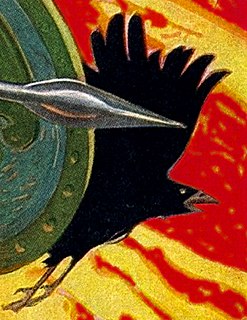
The Morrígan or Mórrígan, also known as Morrígu, is a figure from Irish mythology. The name is Mór-Ríoghain in Modern Irish, and it has been translated as "great queen" or "phantom queen".
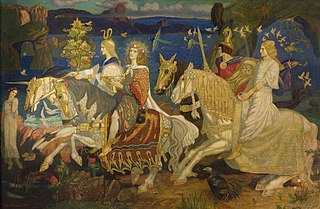
The Tuath(a) Dé Danann, also known by the earlier name Tuath Dé, are a supernatural race in Irish mythology. They are thought to represent the main deities of pre-Christian Gaelic Ireland. The Tuatha Dé Danann constitute a pantheon whose attributes appeared in a number of forms throughout the Celtic world.
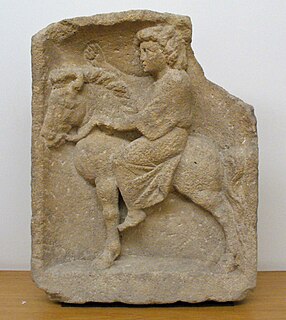
In Gallo-Roman religion, Epona was a protector of horses, ponies, donkeys, and mules. She was particularly a goddess of fertility, as shown by her attributes of a patera, cornucopia, ears of grain and the presence of foals in some sculptures. She and her horses might also have been leaders of the soul in the after-life ride, with parallels in Rhiannon of the Mabinogion. The worship of Epona, "the sole Celtic divinity ultimately worshipped in Rome itself", as the patroness of cavalry, was widespread in the Roman Empire between the first and third centuries AD; this is unusual for a Celtic deity, most of whom were associated with specific localities.

Erecura or Aerecura was a goddess worshipped in ancient times, often thought to be Celtic in origin, mostly represented with the attributes of Proserpina and associated with the Roman underworld god Dis Pater, as on an altar from Sulzbach. She appears with Dis Pater in a statue found at Oberseebach, Switzerland, and in several magical texts from Austria, once in the company of Cerberus and once probably with Ogmios. A further inscription to her has been found near Stuttgart, Germany. Besides her chthonic symbols, she is often depicted with such attributes of fertility as the cornucopia and apple baskets. She is believed to be similar to Greek Hecate, while the two goddesses share similar names. She is depicted in a seated posture, wearing a full robe and bearing trays or baskets of fruit, in depictions from Cannstatt and Sulzbach. Miranda Green calls Aericura a "Gaulish Hecuba", while Noémie Beck characterizes her as a "land-goddess" sharing both underworld and fertility aspects with Dis Pater.
Áine is an Irish goddess of summer, wealth and sovereignty. She is associated with midsummer and the sun, and is sometimes represented by a red mare. She is the daughter of Egobail, the sister of Aillen and/or Fennen, and is claimed as an ancestor by multiple Irish families. As the goddess of love and fertility, she has command over crops and animals and is also associated with agriculture.

Anu or Ana is the name of a goddess mentioned briefly in Irish mythology. The 9th century Sanas Cormaic says in its entry for her: "Ana - mother of the gods of Ireland; well did she feed the gods". She may be a goddess in her own right, or another name for Danu. In the Lebor Gabála Érenn, Anand is given as another name for The Morrígan. As her name is often conflated with a number of other goddesses, it is not always clear which figure is being referred to if the name is taken out of context. The name may be derived from the Proto-Celtic theonym *Φanon-.
In Gallo-Roman religion, Arduinna was the eponymous tutelary goddess of the Ardennes Forest and region, thought to be represented as a huntress riding a boar. Her cult originated in the Ardennes region of present-day Belgium, Luxembourg, and France. She was identified with the Roman goddess Diana.

In Celtic mythology, Nantosuelta is the goddess of nature, the earth, fire and fertility.
Ailill Ollamh in Irish traditional history was the son of Mug Nuadat and was a king of the southern half of Ireland, placed in the 3rd century by early modern Irish genealogy. Sadb ingen Chuinn, daughter of Conn of the Hundred Battles, in her second marriage, married Ailill. He divided the kingdom between his sons Éogan Mór, Cormac Cas, and Cian. Éogan founded the dynasty of the Eóganachta. Sadb's son Lugaid Mac Con, who was Ailill's foster-son, became High King of Ireland.

Ancient Celtic religion, commonly known as Celtic paganism, comprises the religious beliefs and practices adhered to by the Iron Age people of Western Europe now known as the Celts, roughly between 500 BCE and 500 CE, spanning the La Tène period and the Roman era, and in the case of the Insular Celts the British and Irish Iron Age. Very little is known with any certainty about the subject, and apart from documented names, which are thought to be of deities, the only detailed contemporary accounts are by hostile Roman writers, who were probably not well-informed.
Aine may refer to:
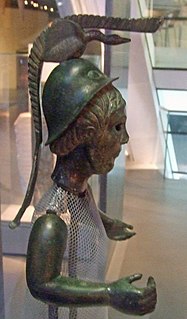
Brigantia or Brigindo was a goddess in Celtic religion of Late Antiquity.

Legananny is a townland 5.6 km (3.5 mi) north of Leitrim, County Down, Northern Ireland. It contains the ancient Legannany Dolmen which has stood for between 4000 and 4500 years. It is made up of three large stones standing upright with a very large stone sitting on top of them. It has been linked with the Irish goddess Áine.
Áine is an Irish female given name. It means "radiance" and was the name of the Irish Celtic goddess of wealth and summer: Áine. Notable people with the name include:
According to classical sources, the ancient Celts were animists. They honoured the forces of nature, saw the world as inhabited by many spirits, and saw the Divine manifesting in aspects of the natural world.
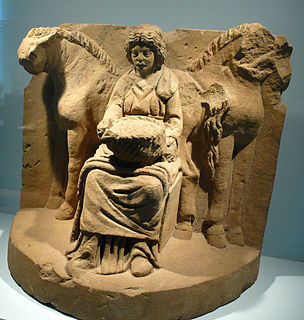
The gods and goddesses of the pre-Christian Celtic peoples are known from a variety of sources, including ancient places of worship, statues, engravings, cult objects and place or personal names. The ancient Celts appear to have had a pantheon of deities comparable to others in Indo-European religion, each linked to aspects of life and the natural world. By a process of syncretism, after the Roman conquest of Celtic areas, these became associated with their Roman equivalents, and their worship continued until Christianization. Pre-Roman Celtic art produced few images of deities, and these are hard to identify, lacking inscriptions, but in the post-conquest period many more images were made, some with inscriptions naming the deity. Most of the specific information we have therefore comes from Latin writers and the archaeology of the post-conquest period. More tentatively, links can be made between ancient Celtic deities and figures in early medieval Irish and Welsh literature, although all these works were produced well after Christianization.

Celtic mythology is the body of myths belonging to the Celtic peoples and ancient Celtic religion. Like other Iron Age Europeans, the Celtic peoples were polytheistic, having many gods and goddesses. For Celts in close contact with Ancient Rome, such as the Gauls and Celtiberians, their mythology did not survive their conquest by the Roman Empire, the loss of their Celtic languages and their subsequent conversion to Christianity. It is mostly through Roman and Greek sources, and archaeology, that traces of their mythology are found. The Insular Celtic peoples, who maintained political or linguistic identities, preserved remnants of their mythologies in oral lore, which were eventually written down by Christian scribes in the Middle Ages. Irish mythology has the largest surviving body of myths, followed by Welsh mythology.
References
- 1 2 L'Arbre Celtique
- ↑ J. A. MacCulloch (1911). ‘Chapter III. The Gods of Gaul and the Continental Celts.’ The Religion of the Ancient Celts. New York: Dover Publications. ISBN 0-486-42765-X Page 47.

